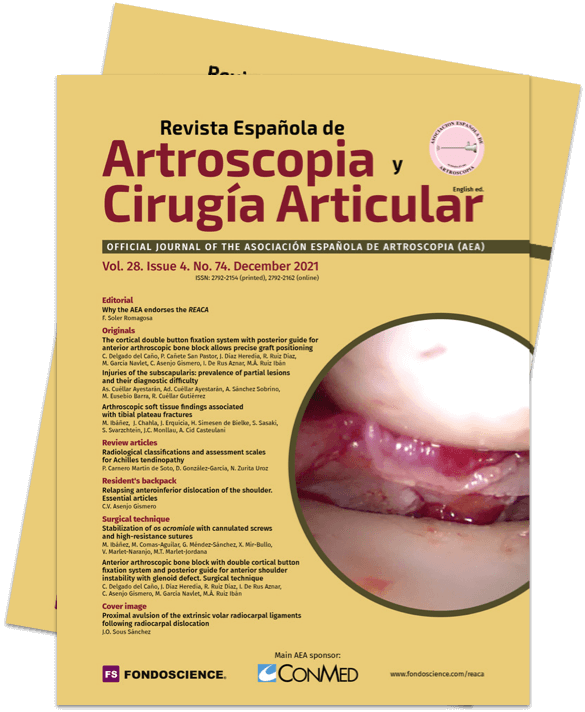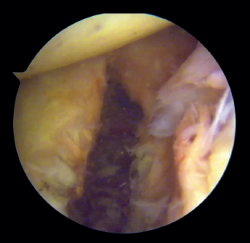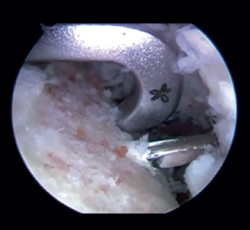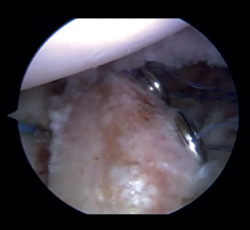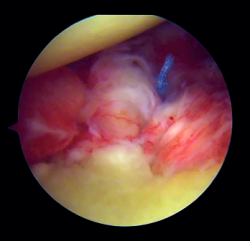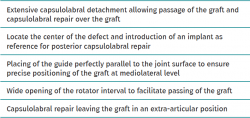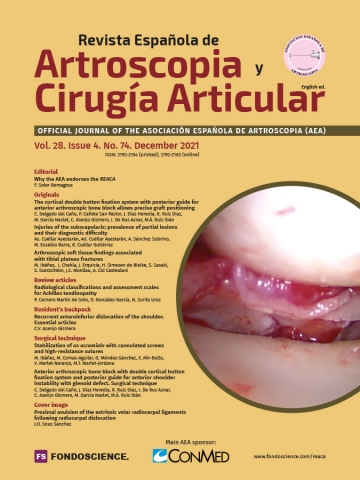Anterior arthroscopic bone block with double cortical button fixation system and posterior guide for anterior shoulder instability with glenoid defect. Surgical technique
Bloque óseo artroscópico anterior con sistema de fijación de doble botón cortical con guía posterior para la inestabilidad anterior de hombro con defecto glenoideo. Técnica quirúrgica
Resumen:
La inestabilidad glenohumeral asocia con frecuencia defectos óseos glenoideos anteroinferiores que requieren técnicas de aporte óseo para la restauración del arco y la superficie articular. En este artículo se describe la técnica de reconstrucción de la glena en pacientes con inestabilidad de hombro mediante aloinjerto óseo anterior fijado con sistema de doble botón cortical.
El paciente se posiciona en decúbito lateral o silla de playa según la preferencia del cirujano. El procedimiento se realiza a través de 3 portales artroscópicos. Una vez confirmada la necesidad de injerto, se descongela el aloinjerto de cresta ilíaca y se prepara y talla a tamaño de 20 × 10 × 10 mm; se perforan 2 orificios separados entre sí 10 mm y a 5 mm de cada extremo y se colocan los botones anteriores y las suturas. Se desinserta el labrum y la cápsula anterior desde las 2 hasta las 6, llegando en medial hasta visualizar fibras musculares del subescapular y la base de la coracoides. Se regulariza el defecto óseo de la glena con fresa, cruentando la superficie hasta dejarla plana. Con una guía glenoidea colocada por el portal posterior se introducen 2 cánulas transglenoideas de detrás a delante. A través de estas cánulas se realiza el paso de los hilos hacia el portal anterior y, con ayuda de dichos hilos, se pasan los hilos de los implantes a través de la glena en su situación definitiva. Traccionando de estos hilos por posterior se introduce el injerto en la articulación y se posiciona en línea con el defecto. Una vez el injerto se encuentra en su posición definitiva anterior, se colocan los botones posteriores y se fijan tensionando a 100 N ambas suturas de forma secuencial. Tras comprobar la buena posición y estabilidad del injerto, se procede a realizar una reparación capsulolabral de Bankart, fijando el complejo capsulolabral con implantes glenoideos sobre el injerto, que queda extraarticular.
Abstract:
Glenohumeral instability is often associated to anteroinferior glenoid bone defects that require the use of bone provision techniques in order to restore the joint surface and arc. The present study describes the glenoid cavity reconstruction technique in patients with shoulder instability using an anterior bone allograft with a double cortical button fixation system.
The patient is placed in lateral decubitus or beach chair position, depending on the preferences of the surgeon. The procedure is performed through three arthroscopic portals. Once the need for grafting is confirmed, the iliac crest allograft is thawed, prepared and sized to 20 × 10 × 10 mm. Two orifices spaced 10 mm apart are then made at 5 mm from each end, with placement of the anterior buttons and the sutures. The labrum and anterior capsule are deinserted from the 2 to the 6 o'clock position, extending medial until the muscle fibres of the subscapularis muscle and base of the coracoid are visualised. The glenoid cavity bone defect is evened with a bur, roughening the surface until leaving it flat. Using a glenoid guide through the posterior portal, two transglenoid cannulas are inserted from back to front. Through the cannulas we pass the threads towards the anterior portal, and with the help of the former, the threads of the implants are advanced through the glenoid cavity to their final position. By exerting traction upon these threads from posterior, the graft is introduced in the joint and is positioned in line with the defect. Once the graft is positioned in its final anterior position, the posterior buttons are placed and affixed tightening both sutures to 100 N in sequence. After confirming the correct position and stability of the graft, capsulolabral Bankart repair is carried out, fixing the capsulolabral complex with glenoid implants over the graft, which is left in an extra-articular position.
Introduction
Glenohumeral instability is often associated to anteroinferior bone defects(1) that require the use of bone provision techniques in order to restore the joint surface and arc. Different types of grafts have been used for this purpose, from autologous coracoid in the Latarjet procedure to free bone grafts. Of these, there have been descriptions of distal tibial allografts(2) and glenoid cavity (3) or femoral and humeral head allografts(4), though at present the most widely used options are iliac crest autografts and allografts.
The success of these procedures largely depends on correct positioning of the bone graft in relation to the glenoid joint surface(5). Thus, although the grafts traditionally have been fixed with metal screws(6) or reabsorbable screws or plates, double button devices have recently been introduced(7,8), seeking not only to improve positioning of the graft but also to reduce the complications associated with the other fixation systems(9). The series published in the literature report excellent outcomes in terms of graft positioning(10). The present study and accompanying video describe a glenoid cavity reconstruction technique in patients with shoulder instability using an anterior bone allograft with a double cortical button fixation system.
Surgical technique
The described surgical technique is based on the technique described by Eden and Hybinette(11,12), adapted for arthroscopic application by Scheibel(13) and subsequently modified by Taverna et al.(14).
Preparation of the graft
Firstly, in a separate surgical field, the graft is prepared and sized to 20 × 10 × 10 mm. Using a 2.8 mm drill and with the help of a guide, two orifices spaced 10 mm apart are made at 5 mm from each end, with placement of the button and suture system through them, positioning the anterior buttons in the graft.
Preparation of the joint (Figure 1)
The patient is placed in lateral decubitus or beach chair position, depending on the preferences of the surgeon. A complete arthroscopic exploration is made through three standard portals, and the lesions are identified. The labrum and anterior capsule are then detached from the 2 to the 6 o'clock position, taking care to preserve their continuity. It is important to perform carefully detach labrum from the glenoid rim and remove all soft tissue until de muscle fibres of the subscapularis muscle and base of the coracoid are visualised. This will make easier the introduction of the graft and the creation of a flat bony surface to accommodate the graft.
We then address the bone defect: with the glenoid defect exposed, the defect is evened, with drilling and roughening of the glenoid cavity neck until a flat and uniform surface is obtained on which to position the graft. The central point of the defect is selected for positioning of the graft, and an implant is inserted as a reference that subsequently will be used for capsulolabral repair.
Introduction of the glenoid guide and positioning of the sheaths
(Figures 2 and 3)
Arthroscope is introduced through the anterosuperior portal, and the glenoid guide is introduced through the posterior portal, and passed paralel to the glenoid surface until the hook is located at the centre of the bone defect. The guide is secured with two cannulas inserted through two small accessory incisions, until connecting with the posterior cortical layer. Both cortical layers are drilled through them using a 2.8 mm drill fitted with a sheath so that on withdrawing the drill the sheath is positioned at drilling level. This step is made twice to introduce two sheaths: one above and the other below the glenoid guide hook and spaced 10 mm apart. Through these sheaths we advance two monofilament loops that are retrieved sequentially through the anterior portal for subsequent passing of the graft. At this point we can remove both sheaths and the glenoid guide, taking care to prevent the guide hook from coming into contact with the glenoid surface in order to avoid damaging to the cartilage.
Introduction and fixation of the graft (Figure 4)
The cannula is removed from the anterior portal, from the posterior viewing portal, rotator interval is widened in order to facilitate introduction of the graft. Using both monofilaments, the graft traction threads are inserted from front to back. The graft is introduced into the joint, applying traction upon the threads from the posterior position. The graft is placed in line with the defect and within the capsulolabral structures. Once the graft is positioned in its final anterior position, the posterior buttons are placed by means of the traction threads and are fixed via a self-stabilizing running suture, tightening to 100 N with the help of a tensiometre, in sequence.
Capsulolabral repair (Figure 5)
After confirming the correct position and stability of the graft, capsulolabral tissues are repaired using glenoid implants, leaving the graft extra-articular.
Postoperative management
During the postoperative period, the patients are immobilised in a sling in 15° abduction for four weeks after the operation. At this point passive mobilisation can begin. From week 6, active mobilisation can be allowed, and after 12 weeks scapular girdle strengthening exercises are started. Contact sports are not allowed until 6 months after surgery.
Table 1 summarises the key points of the procedure.
Discussion
The restoration of the glenoid joint surface in patients with anterior glenohumeral instability and bone defects is a challenge. In patients with major glenoid bone defects, many authors consider the Latarjet as the gold standard treatment, with many studies evidencing satisfactory short- and long-term outcomes(15,16). However, this is a non-anatomical technique with a relatively high incidence of complications, also, the treatment after its failure is difficult(17). The arthroscopic bone block procedure allows us to restore stability and at the same time preserve the integrity of the tendon of the subscapularis muscle(13), and has fewer complications than the Latarjet procedure(17). Although this procedure does not reproduce the triple block effect produced by the Latarjet technique, this might not be necessary in patients with less significant bone defects and repairable soft tissues(7). These are in fact the patients of our study: patients with glenoid bone defects of over 5% but under 20%, and with good soft tissue conditions in which soft tissue repair alone might not be enough to avoid recurrences, but with bone defects of insufficient relevance to indicate a Latarjet technique. Stability is restored with a lesser incidence of complications, moreover, Latarjet procedure may still be an option if this procedure fails.
This procedure has been described for an arthroscopic approach. Its relatively recent adaptation implies that few studies analysing its outcomes are available. In addition, different modifications of the technique are being introduced. One of them is the use of cortical double button devices for fixing the graft. These devices are considered to allow a more precise positioning of the graft, resulting in greater appositioning, contact and integration of the latter(7). Key elements in this regard include the accompanying guides that help to position the graft centred with respect to the bone defect and in line with the glenoid joint surface(18). In addition, the use of tensiometres allows compression and stable fixation of the grafts(18). These elements moreover have been associated with fewer neurological complications and material irritation phenomena traditionally related to screws, oblying to its removal(9,19). None of the published series that use this fixation system reflect postoperative complications related to these devices(7,20), in contrast to the use of screws, where the complications rate reaches 6.5% according to Butt(9). On the other hand, the results obtained in terms of positioning are good with this procedure, as evidenced by Taverna et al.(7) and Boileau et al.(8), who achieved precise positionings in the craniocaudal axis in 92.3% and 100% of the patients respectively, with precise axial positions in all of the cases in both series. It should be noted that both authors also used the double button device with the posterior guide.
Conclusions
The described technique for arthroscopic repair of anterior glenohumeral instability using a cortical double button fixation system with posterior guide is both reproducible and precise in positioning the bone graft.
Supplementary material (Video 1)
Video 1. Anterior arthroscopic bone block with double cortical button fixation system and posterior guide for anterior shoulder instability with glenoid defect. Surgical technique.
Figuras
Figure 1. View from the anterosuperior portal (left shoulder). Note the flat glenoid surface after drilling and roughening of the glenoid bed and deinsertion of the anteroinferior capsulolabral complex.
Figure 2. View from the anterosuperior portal (left shoulder). Note the glenoid guide positioned at the centre of the defect and drilling at its upper and lower portion, spaced 10 mm apart.
Figure 3. View from the anterosuperior portal (left shoulder). Monofilaments inserted through the sheaths from posterior to anterior for subsequent passing of the threads that will introduce the graft.
Figure 4. View from the posterior portal (left shoulder). Insertion of the graft by means of the traction threads and positioning in line with the bone defect.
Figure 5. View from the posterior portal (left shoulder). Capsulolabral repair by means of glenoid implants, leaving the graft in an extra-articular position.
Tablas
Información del artículo
Cita bibliográfica
Autores
Cristina Delgado del Caño
Unidad de Traumatología. Hospital Monográfico Asepeyo Coslada. Madrid
Hospital Universitario Fundación Jiménez Díaz. Madrid
Jorge Díaz Heredia
Cirugía Ortopédica y Traumatología. Unidad de Hombro y Codo. Hospital Universitario Ramón y Cajal. Madrid
Clínica La Antigua. Guadalajara
Editor asociado de REACA
Raquel Ruiz Díaz
Servicio de Cirugía Ortopédica y Traumatología, Hospital Universitario Ramón y Cajal, Madrid, España
Ignacio de Rus Aznar
Servicio de Cirugía Ortopédica y Traumatología. Clinica CEMTRO. Madrid
Unidad de Hombro y Codo. Hospital Universitario Ramón y Cajal. Madrid
Servicio de Cirugía Ortopédica y Traumatología. Hospital Monográfico Asepeyo Coslada. Madrid
Hospital Universitario de Torrejón. Madrid
Cristina Victoria Asenjo Gismero
Equipo +Qtrauma. Hombro y Codo. Hospital Beata María Ana. Madrid
Unidad de Miembro Superior. Hospital FREMAP Majadahonda. Madrid
Cirugía Ortopédica y Traumatología, Hospital ASEPEYO, Coslada, Madrid, España
Miguel García Navlet
Grupo +QTrauma. Hospital Beata María Ana. Madrid
Sección de Traumatología, Unidad de patología de hombro y codo, Hospital ASEPEYO, Coslada, Madrid, España
Unidad de Hombro y Codo. +QTrauma. Hospital Beata María Ana. Madrid
Miguel Ángel Ruiz Ibán
Cirugía Ortopédica y Traumatología. Unidad de Hombro y Codo. Hospital Universitario Ramón y Cajal. Madrid
Director de REACA
Ethical responsibilities
Conflicts of interest. The authors state that they have no conflicts of interest.
Financial support. This study has received no financial support.
Protection of people and animals. The authors declare that this research has not involved human or animal experimentation.
Data confidentiality. The authors declare that the protocols of their work centre referred to the publication of patient information have been followed.
Right to privacy and informed consent. The authors have obtained informed consent from the patients and/or subjects cited in the article. The mentioned document is filed by the corresponding author.
Referencias bibliográficas
-
1Yamamoto N, Itoi E, Abe H, et al. Contact between the glenoid and the humeral head in abduction, external rotation, and horizontal extension: a new concept of glenoid track. J Shoulder Elbow Surg. 2007;16(5):649-56.
-
2Provencher MT, Frank RM, Golijanin P, et al. Distal Tibia Allograft Glenoid Reconstruction in Recurrent Anterior Shoulder Instability: Clinical and Radiographic Outcomes. Arthroscopy. 2017;33(5):891-7.
-
3Skendzel JG, Sekiya JK. Arthroscopic glenoid osteochondral allograft reconstruction without subscapularis takedown: technique and literature review. Arthroscopy. 2011;27(1):129-35.
-
4Villatte G, Spurr S, Broden C, Martins A, Emery R, Reilly P. The Eden-Hybbinette procedure is one hundred years old! A historical view of the concept and its evolutions. Int Orthop. 2018;42(10):2491-5.
-
5Longo UG, Loppini M, Rizzello G, Ciuffreda M, Maffulli N, Denaro V. Latarjet, Bristow, and Eden-Hybinette procedures for anterior shoulder dislocation: systematic review and quantitative synthesis of the literature. Arthroscopy. 2014;30(9):1184-211.
-
6Steffen V, Hertel R. Rim reconstruction with autogenous iliac crest for anterior glenoid deficiency: forty-three instability cases followed for 5-19 years. J Shoulder Elbow Surg. 2013;22(4):550-9.
-
7Taverna E, Garavaglia G, Perfetti C, Ufenast H, Sconfienza LM, Guarrella V. An arthroscopic bone block procedure is effective in restoring stability, allowing return to sports in cases of glenohumeral instability with glenoid bone deficiency. Knee Surg Sports Traumatol Arthrosc. 2018;26(12):3780-7.
-
8Boileau P, Duysens C, Saliken D, Lemmex DB, Bonnevialle N. All-arthroscopic, guided Eden-Hybbinette procedure using suture-button fixation for revision of failed Latarjet. J Shoulder Elbow Surg. 2019;28(11):e377-e388.
-
9Butt U, Charalambous CP. Complications associated with open coracoid transfer procedures for shoulder instability. J Shoulder Elbow Surg. 2012;21(8):1110-9.
-
10Delgado del Caño C, Cañete San Pastor P, Díaz Heredia J, et al. El sistema de fijación de doble botón cortical con guía posterior para bloque óseo artroscópico anterior logra posiciones precisas del injerto. Rev Esp Artrosc Cir Articul. 2021;28(4):223-30.
-
11Eden R. Zur Operation der habituellen Schulterluxation unter Mitteilung eines neuen verfahrens bei Abriß am inneren Pfannenrande. Deutsche Zeitschrift für Chirurgie. 1918;144(3):269-80.
-
12Hybbinette. De la transplantation d’un fragment osseux pour remédier aux luxations récidivantes de l’épaule; constations et résultats opératoires. Acta Chir Scand. 1932;71:411-45.
-
13Scheibel M, Kraus N, Diederichs G, Haas NP. Arthroscopic reconstruction of chronic anteroinferior glenoid defect using an autologous tricortical iliac crest bone grafting technique. Arch Orthop Trauma Surg. 2008;128(11):1295-300.
-
14Taverna E, D'Ambrosi R, Perfetti C, Garavaglia G. Arthroscopic Bone Graft Procedure for Anterior Inferior Glenohumeral Instability. Arthrosc Tech. 2014;3(6):e653-e660.
-
15Mizuno N, Denard PJ, Raiss P, Melis B, Walch G. Long-term results of the Latarjet procedure for anterior instability of the shoulder. J Shoulder Elbow Surg. 2014;23(11):1691-9.
-
16Chillemi C, Guerrisi M, Paglialunga C, Salate Santone F, Osimani M. Latarjet procedure for anterior shoulder instability: a 24-year follow-up study. Arch Orthop Trauma Surg. 2021 Feb;141(2):189-96.
-
17Griesser MJ, Harris JD, McCoy BW, et al. Complications and re-operations after Bristow-Latarjet shoulder stabilization: a systematic review. J Shoulder Elbow Surg. 2013;22(2):286-92.
-
18Kordasiewicz B, Kicinski M, Malachowski K, Wieczorek J, Chaberek S, Pomianowski S. Comparative study of open and arthroscopic coracoid transfer for shoulder anterior instability (Latarjet)-computed tomography evaluation at a short term follow-up. Part II. Int Orthop. 2018;42(5):1119-28.
-
19Kalogrianitis S, Tsouparopoulos V. Arthroscopic Iliac Crest Bone Block for Reconstruction of the Glenoid: A Fixation Technique Using an Adjustable-Length Loop Cortical Suspensory Fixation Device. Arthrosc Tech. 2016;5(6):e1197-e1202.
-
20Boileau P, Saliken D, Gendre P, et al. Arthroscopic Latarjet: Suture-Button Fixation Is a Safe and Reliable Alternative to Screw Fixation. Arthroscopy. 2019;35(4):1050-61.
Descargar artículo:
Licencia:
Este contenido es de acceso abierto (Open-Access) y se ha distribuido bajo los términos de la licencia Creative Commons CC BY-NC-ND (Reconocimiento-NoComercial-SinObraDerivada 4.0 Internacional) que permite usar, distribuir y reproducir en cualquier medio siempre que se citen a los autores y no se utilice para fines comerciales ni para hacer obras derivadas.
Comparte este contenido
En esta edición
- Why the AEA endorses the REACA
- The cortical double button fixation system with posterior guide for anterior arthroscopic bone block allows precise graft positioning
- Injuries of the subscapularis: prevalence of partial lesions and their diagnostic difficulty
- Arthroscopic soft tissue findings associated with tibial plateau fractures
- Radiological classifications and assessment scales for Achilles tendinopathy
- Recurrent anteroinferior dislocation of the shoulder. Essential articles
- Stabilization of <em>os acromiale</em> with cannulated screws and high-resistance sutures
- Anterior arthroscopic bone block with double cortical button fixation system and posterior guide for anterior shoulder instability with glenoid defect. Surgical technique
- Proximal avulsion of the extrinsic volar radiocarpal ligaments following radiocarpal dislocation
Más en PUBMED
Más en Google Scholar
Más en ORCID


Revista Española de Artroscopia y Cirugía Articular está distribuida bajo una licencia de Creative Commons Reconocimiento-NoComercial-SinObraDerivada 4.0 Internacional.

